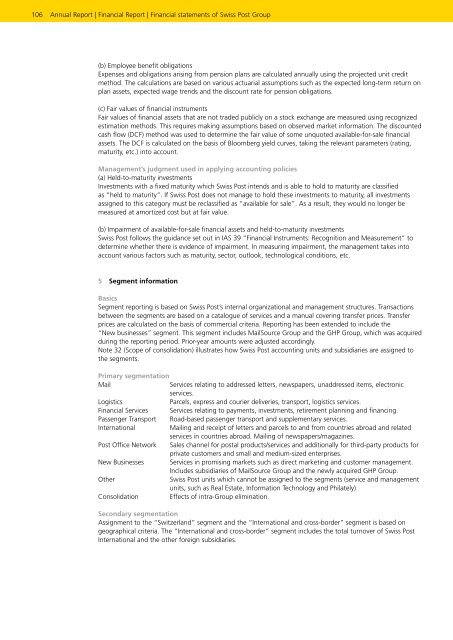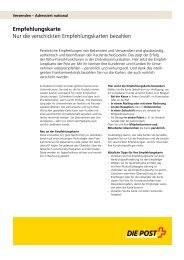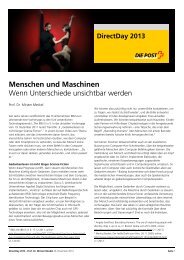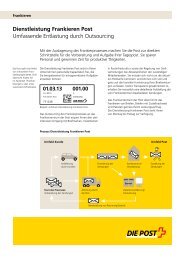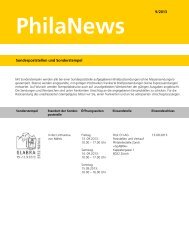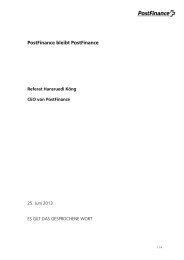Service-oriented - Die Schweizerische Post
Service-oriented - Die Schweizerische Post
Service-oriented - Die Schweizerische Post
You also want an ePaper? Increase the reach of your titles
YUMPU automatically turns print PDFs into web optimized ePapers that Google loves.
106 Annual Report | Financial Report | Financial statements of Swiss <strong>Post</strong> Group<br />
(b) Employee benefit obligations<br />
Expenses and obligations arising from pension plans are calculated annually using the projected unit credit<br />
method. The calculations are based on various actuarial assumptions such as the expected longterm return on<br />
plan assets, expected wage trends and the discount rate for pension obligations.<br />
(c) Fair values of financial instruments<br />
Fair values of financial assets that are not traded publicly on a stock exchange are measured using recognized<br />
estimation methods. This requires making assumptions based on observed market information. The discounted<br />
cash flow (DCF) method was used to determine the fair value of some unquoted availableforsale financial<br />
assets. The DCF is calculated on the basis of Bloomberg yield curves, taking the relevant parameters (rating,<br />
maturity, etc.) into account.<br />
Management’s judgment used in applying accounting policies<br />
(a) Heldtomaturity investments<br />
Investments with a fixed maturity which Swiss <strong>Post</strong> intends and is able to hold to maturity are classified<br />
as “held to maturity”. If Swiss <strong>Post</strong> does not manage to hold these investments to maturity, all investments<br />
assigned to this category must be reclassified as “available for sale”. As a result, they would no longer be<br />
measured at amortized cost but at fair value.<br />
(b) Impairment of availableforsale financial assets and heldtomaturity investments<br />
Swiss <strong>Post</strong> follows the guidance set out in IAS 39 “Financial Instruments: Recognition and Measurement” to<br />
determine whether there is evidence of impairment. In measuring impairment, the management takes into<br />
account various factors such as maturity, sector, outlook, technological conditions, etc.<br />
5 Segment information<br />
Basics<br />
Segment reporting is based on Swiss <strong>Post</strong>’s internal organizational and management structures. Transactions<br />
between the segments are based on a catalogue of services and a manual covering transfer prices. Transfer<br />
prices are calculated on the basis of commercial criteria. Reporting has been extended to include the<br />
“New businesses” segment. This segment includes MailSource Group and the GHP Group, which was acquired<br />
during the reporting period. Prioryear amounts were adjusted accordingly.<br />
Note 32 (Scope of consolidation) illustrates how Swiss <strong>Post</strong> accounting units and subsidiaries are assigned to<br />
the segments.<br />
Primary segmentation<br />
Mail <strong>Service</strong>s relating to addressed letters, newspapers, unaddressed items, electronic<br />
services.<br />
Logistics Parcels, express and courier deliveries, transport, logistics services.<br />
Financial <strong>Service</strong>s <strong>Service</strong>s relating to payments, investments, retirement planning and financing.<br />
Passenger Transport Roadbased passenger transport and supplementary services.<br />
International Mailing and receipt of letters and parcels to and from countries abroad and related<br />
services in countries abroad. Mailing of newspapers/magazines.<br />
<strong>Post</strong> Office Network Sales channel for postal products/services and additionally for thirdparty products for<br />
private customers and small and mediumsized enterprises.<br />
New Businesses <strong>Service</strong>s in promising markets such as direct marketing and customer management.<br />
Includes subsidiaries of MailSource Group and the newly acquired GHP Group.<br />
Other Swiss <strong>Post</strong> units which cannot be assigned to the segments (service and management<br />
units, such as Real Estate, Information Technology and Philately).<br />
Consolidation Effects of intraGroup elimination.<br />
Secondary segmentation<br />
Assignment to the “Switzerland” segment and the “International and crossborder” segment is based on<br />
geographical criteria. The “International and crossborder” segment includes the total turnover of Swiss <strong>Post</strong><br />
International and the other foreign subsidiaries.


